Related Research Articles

Katwa is a sub-divisional town and railway junction in Purba Bardhaman district of the Indian state of West Bengal. It is the headquarters of the Katwa subdivision. The town was built at the confluence of Ganga and Ajay. Katwa is a border city of three districts; Purba Bardhaman District, Nadia District and Murshidabad District.

Bardhaman district was a district in West Bengal. On 7 April 2017, the district was bifurcated into two districts: Purba Bardhaman and Paschim Bardhaman district. The headquarters of the district was Bardhaman, and it housed the cities of Asansol and Durgapur. Indian revolutionary Rashbehari Bose was born in village Subaldaha, Bardhaman district. Bengali poet Kumud Ranjan Mullick was born at Kogram and poet Kazi Nazrul Islam was born at Churulia in the same district. Notable persons like Prabhat Kumar Mukhopadhyay, Akshay Kumar Datta, Jatindranath Sengupta were also born in erstwhile Bardhaman district. It was the seventh most populous district in India at the time of bifurcation.
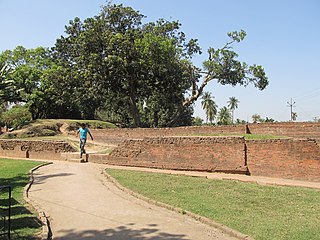
Chandraketugarh is a 2,500 years old archaeological site located near the Bidyadhari river, about 35 kilometres (22 mi) north-east of Kolkata, India, in the district of North 24 parganas, near the township of Berachampa and the Harua Road railhead. Once it was an important hub of international maritime trade. A museum has been built near the site depicting largely collections of Dilip Kumar Maity, a retired school teacher and amateur archaeologist.

The Geography of West Bengal, a state in eastern India, is primarily defined by plains and plateaus, with the high peaks of the Himalayas in the north and the Bay of Bengal to the south.

Rarh region is a toponym for an area in the Indian subcontinent that lies between the Chota Nagpur Plateau on the West and the Ganges Delta on the East. Although the boundaries of the region have been defined differently according to various sources throughout history, it is mainly coextensive with the state of West Bengal, also comprising parts of the state of Jharkhand in India. Linguistically, the region is defined with population speaking the Rarhi local Bengali dialect.

Guskara is a town and a municipality under the Ausgram police station in Bardhaman Sadar North subdivision of Purba Bardhaman district in the Indian state of West Bengal.

Tamralipta or Tamralipti was a port city and capital of Suhma Kingdom in ancient India, located on the coast of the Bay of Bengal. The Tamluk town in present-day Purba Medinipur, West Bengal, is generally identified as the site of Tamralipti.

The Wari-Bateshwar ruins in Narsingdi, Dhaka Division, Bangladesh is one of the oldest urban archaeological sites in Bangladesh. Excavation in the site unearthed a fortified urban center, paved roads and suburban dwelling. The site was primarily occupied during the Iron Age, from 400 to 100 BCE, as evidenced by the abundance of punch-marked coins and Northern Black Polished Ware (NBPW) artifacts.

The University of Burdwan is a public collegiate state university located in Purba Bardhaman, West Bengal, India. It was established by the West Bengal Government as a teaching and affiliating university on 15 June 1960 with six graduate departments and 30 undergraduate colleges spread over three districts that come under the jurisdiction of the university. The university currently offers more than 30 undergraduate and 66 postgraduate courses.
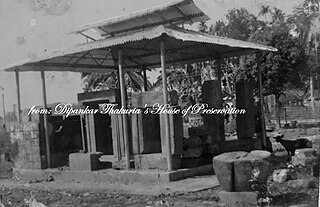
Chand Sadagar was a rich and powerful sea merchant of Champaknagar in Eastern India. This merchant has been claimed by both the Assamese and Bengali people of India to be associated with their respective states and communities. Medieval Bengali poet Bipradas Pipilai mentioned in his "Manasamangal Kāvya" that merchant ship of Chand Sadagar used to proceed to the sea from ancient Champaknagar of Kamarupa after passing through Tribeni, situated at the junction of Saptagram and the confluence of Ganges, Saraswati and Jamuna River of modern-day West Bengal. Narayan Dev in the Assamese scriptures gave an account in his Manasamangal about the merchant ship of the trader Chand Saudagar proceeding to the sea from ancient Champaknagar of Assam passing through Saptagram and Tribeni, the tri-junction of the Ganges, Saraswati and Jamuna River. In the Padmapuran, account of Chand Bania (Sadagar) is specifically mentioned.

Pandu Rajar Dhibi in the valley of the river Ajay is an Archaeological site in Ausgram II block in the Sadar North subdivision of Purba Bardhaman district in the Indian state of West Bengal. It was the first Chalcolithic site discovered in West Bengal. It was excavated by a team led by Dr. Paresh Chandra Dasgupta. The common man believes that the main mound at Pandu Rajar Dhibi is associated with King Pandu mentioned in the epic Mahabharata, hence the name came into being from the folklore.
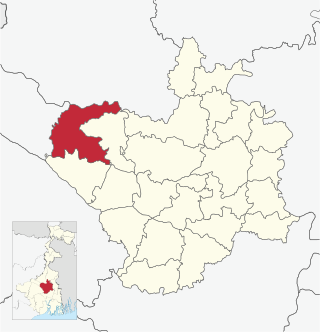
Ausgram II is a community development block that forms an administrative division in Bardhaman Sadar North subdivision of Purba Bardhaman district in the Indian state of West Bengal.
Kogram is a village in Ketugram I CD block in Katwa subdivision of Purba Bardhaman district in West Bengal, India.
Nutanhat is a village in Mongalkote CD block in Katwa subdivision of Purba Bardhaman district in the state of West Bengal, India.

Purba Bardhaman district is in West Bengal. Its headquarters is in Bardhaman. It was formed on 7 April 2017 after the division of the previous Bardhaman district. Great revolutionary Rash Behari Bose was born in village Subaldaha in the district of Purba Bardhaman.
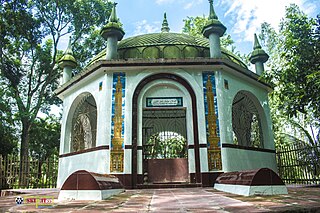
Patharghata is an ancient city and one of the most important archeological sites in Bangladesh located in Joypurhat district. It is located at Patharghata in Panchbibi upazila of the district. The Patharghata site is the site of several archeological sites. It is situated on the bank of the river Tulsiganga, 1.5 km east of the upazila headquarters. Traces of the ruins of this ancient city are found on both banks of the Tulsiganga River.

Jatar Deul also called tower temple (rekha-deul), is located in the numerous rivers criss-crossed by stone-free alluvial and bush landscape of the southern Sundarbans settlements in the Indian state of West Bengal. It belongs to a small sub-group of Bengal temples, the architectural suggestions from Odisha can be traced back. However, this type of brick temple we can see at Nebia Khera, Uttar Pradesh.
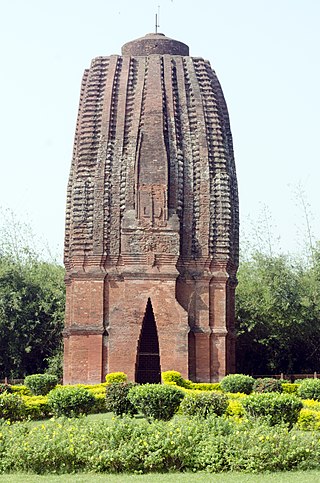
Sat Deul is a 10th-11th century temple at Deule / Sat Deule in the Memari I CD block in the Bardhaman Sadar South subdivision of the Purba Bardhaman district in the Indian state of West Bengal.

Baidyapur Jora Deul is a 16th-century temple at Baidyapur in the Kalna II CD block in the Kalna subdivision of the Purba Bardhaman district in the Indian state of West Bengal.
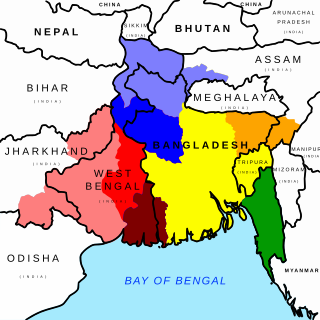
Bengal temple architecture is about temple styles developed and used in Bengal, particularly the chala, ratna and dalan temples.
References
- 1 2 Ghosh, Shibshankar (2000). Gopbhumer Swarup, Aitijhya O Sanskriti. pp. 99–107. Retrieved 16 September 2023.
- ↑ "Mangalkot2 - Banglapedia". en.banglapedia.org. Retrieved 16 September 2023.
- ↑ Sanyal, Rajat; Chattopadhyay, R.K.; Bandyopadhyay, Kumkum. "Early Village Farming Settlements of Eastern India: A Fresh Appraisal" (PDF): 78.
{{cite journal}}: Cite journal requires|journal=(help) - ↑ Saha, Siddhartha (14 November 1975). "An Archaeological Study of Kunur River Basin, Barddhaman District, West Bengal" (PDF). Archives for Dermatological Research. Heritage: Journal of Multidisciplinary Studies in Archaeology. 254 (1): 23–28. Retrieved 16 September 2023.